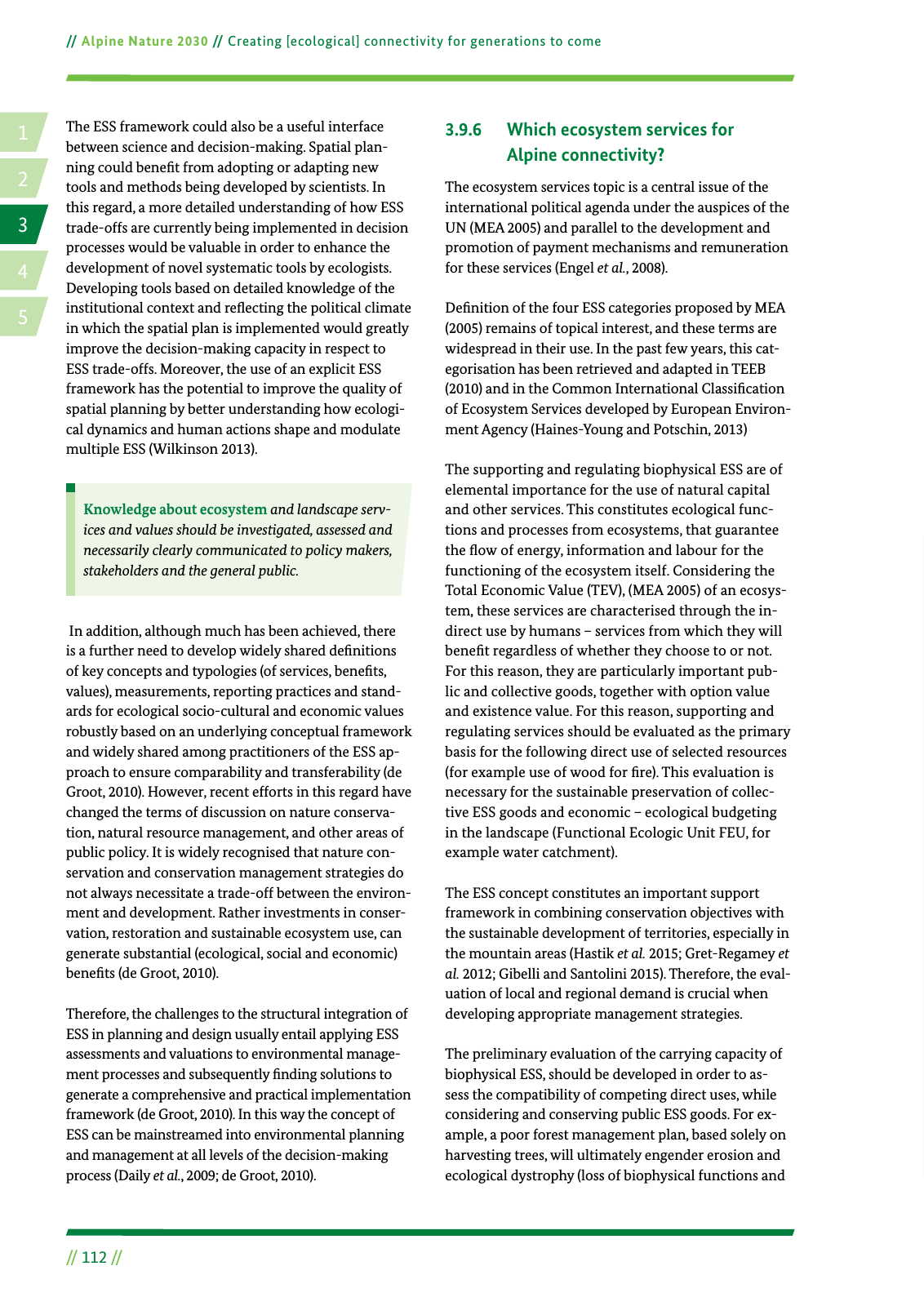14 2 5 3 Alpine Nature 2030 Creating ecological connectivity for generations to come 112 The ESS framework could also be a useful interface between science and decision making Spatial plan ning could bene t from adopting or adapting new tools and methods being developed by scientists In this regard a more detailed understanding of how ESS trade offs are currently being implemented in decision processes would be valuable in order to enhance the development of novel systematic tools by ecologists Developing tools based on detailed knowledge of the institutional context and re ecting the political climate in which the spatial plan is implemented would greatly improve the decision making capacity in respect to ESS trade offs Moreover the use of an explicit ESS framework has the potential to improve the quality of spatial planning by better understanding how ecologi cal dynamics and human actions shape and modulate multiple ESS Wilkinson 2013 Knowledge about ecosystem and landscape serv ices and values should be investigated assessed and necessarily clearly communicated to policy makers stakeholders and the general public In addition although much has been achieved there is a further need to develop widely shared de nitions of key concepts and typologies of services bene ts values measurements reporting practices and stand ards for ecological socio cultural and economic values robustly based on an underlying conceptual framework and widely shared among practitioners of the ESS ap proach to ensure comparability and transferability de Groot 2010 However recent efforts in this regard have changed the terms of discussion on nature conserva tion natural resource management and other areas of public policy It is widely recognised that nature con servation and conservation management strategies do not always necessitate a trade off between the environ ment and development Rather investments in conser vation restoration and sustainable ecosystem use can generate substantial ecological social and economic benefits de Groot 2010 Therefore the challenges to the structural integration of ESS in planning and design usually entail applying ESS assessments and valuations to environmental manage ment processes and subsequently nding solutions to generate a comprehensive and practical implementation framework de Groot 2010 In this way the concept of ESS can be mainstreamed into environmental planning and management at all levels of the decision making process Daily et al 2009 de Groot 2010 3 9 6 Which ecosystem services for Alpine connectivity The ecosystem services topic is a central issue of the international political agenda under the auspices of the UN MEA 2005 and parallel to the development and promotion of payment mechanisms and remuneration for these services Engel et al 2008 De nition of the four ESS categories proposed by MEA 2005 remains of topical interest and these terms are widespread in their use In the past few years this cat egorisation has been retrieved and adapted in TEEB 2010 and in the Common International Classi cation of Ecosystem Services developed by European Environ ment Agency Haines Young and Potschin 2013 The supporting and regulating biophysical ESS are of elemental importance for the use of natural capital and other services This constitutes ecological func tions and processes from ecosystems that guarantee the ow of energy information and labour for the functioning of the ecosystem itself Considering the Total Economic Value TEV MEA 2005 of an ecosys tem these services are characterised through the in direct use by humans services from which they will bene t regardless of whether they choose to or not For this reason they are particularly important pub lic and collective goods together with option value and existence value For this reason supporting and regulating services should be evaluated as the primary basis for the following direct use of selected resources for example use of wood for re This evaluation is necessary for the sustainable preservation of collec tive ESS goods and economic ecological budgeting in the landscape Functional Ecologic Unit FEU for example water catchment The ESS concept constitutes an important support framework in combining conservation objectives with the sustainable development of territories especially in the mountain areas Hastik et al 2015 Gret Regamey et al 2012 Gibelli and Santolini 2015 Therefore the eval uation of local and regional demand is crucial when developing appropriate management strategies The preliminary evaluation of the carrying capacity of biophysical ESS should be developed in order to as sess the compatibility of competing direct uses while considering and conserving public ESS goods For ex ample a poor forest management plan based solely on harvesting trees will ultimately engender erosion and ecological dystrophy loss of biophysical functions and

Hinweis: Dies ist eine maschinenlesbare No-Flash Ansicht.
Klicken Sie hier um zur Online-Version zu gelangen.
Klicken Sie hier um zur Online-Version zu gelangen.